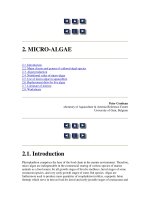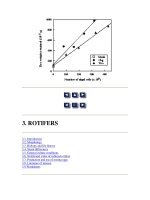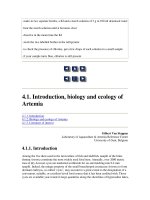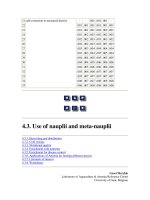The preparation and use of compost - Part 2 ppsx
Bạn đang xem bản rút gọn của tài liệu. Xem và tải ngay bản đầy đủ của tài liệu tại đây (156.83 KB, 11 trang )
The composting process 11
3 The composting process
As described in the section on organic matter in soil processes, the
composting process happens due to the activity of micro-organisms
(bacteria) and other larger organisms like worms and insects. These
need certain conditions to live. These include moisture and air.
To make the best possible compost, the micro-organisms must be able
to work optimally. This can be achieved if the following four factors
are combined to the best advantage:
? type of organic material
? air
? moisture
? temperature
The acidity (pH) is also considered by some to be an important factor.
Acidity depends on the air and moisture flow. A compost heap that is
properly composed will seldom get too acid.
The composting process will be optimal when:
? various materials of different decomposition rates are combined;
? the different materials are well mixed;
? the size of the heap varies from 1 x 1 meters to 3 x 3 meters. This
makes it possible for the temperature to stay constant within the
heap.
A good composting process passes through 3 consecutive stages, these
are as follows:
? a heating phase (fermentation)
? a cooling down phase
? a maturation phase
It is not easy to draw the line between these stages. The process takes
place very gradually and with the help of continuously changing mi-
cro-organisms the organic material is converted into compost.
The preparation and use of compost 12
3.1 Heating phase
During the first stage of composting, the compost heap starts to heat
up considerably. This effect is known as fermentation and is the result
of the breaking down of the complex and tough fibrous material of the
organic matter. This fermentation process (decomposition) is strongest
in the centre of the heap.
To get the fermentation going quickly and effectively, a number of
factors are important. In the first place the compost heap should be
made of all sorts of organic materials. Secondly, the right micro-
organisms have to be present. Thirdly, it is very important that there is
adequate oxygen and water. If these three conditions are met, heat is
generated quickly. In the next chapter we explain how to meet these
conditions when putting compost making into practice.
During fermentation the micro-organisms multiply and change at a
rapid rate, which adds to the heating up process. In this way, a self-
accelerated process is started. The fermentation stage usually begins
after 4-5 days and may take 1-2 weeks.
Maximum fermentation takes place at a temperature of 60-70
o
C in the
compost heap. If the temperature is too high, the necessary micro-
organisms may die and decomposition comes to a halt.
Due to its temperature, fermentation also has a hygienic effect. In the
organic material, many pathogenic germs that are a threat to man,
animal and plant, are destroyed. It is often suggested that fermentation
kills weed seeds and roots too. However, in practice, this is quite dis-
appointing. Many weed seeds are not destroyed in a normal compost
heap, because the temperature is not sufficiently high. In some cases,
the germinating power of weed seeds has even been known to in-
crease.
Temperature test
A simple way to see if the fermentation process has started is as fol-
lows: put a stick in the centre of the heap about 5 days after complet-
ing the compost heap or after the final turning over. Leave it there for
about 5 to 10 minutes.
The composting process 13
After taking it out, feel it immediately. It should be considerably
warmer (60 - 70
o
C) than body temperature. If not, then this is an indi-
cation that something is wrong, perhaps the material used or aeration
is at fault.
3.2 Cooling down phase
The fermentation phase gradually changes into a cooling down phase.
Decomposition occurs without much generation of heat and the tem-
perature drops slowly.
During this period new types of micro-organisms convert the organic
components into humus. The heap remains clammy and hot inside and
the temperature drops from 50
o
C to 30
o
C. By regulating the tempera-
ture, air and water supply, the process can be accelerated or slowed
down. How long this cooling down stage takes, depends on the type of
heap, the material, the attention given to it, the climate etc.
The cooling down period usually takes a few months, but in unfavour-
able conditions may require up to a year.
3.3 Maturation phase
In this end phase of decomposition, the temperature drops to soil tem-
perature, depending on the climate, 15-25
o
C.
Apart from the micro-organisms mentioned, the large soil fauna are
active at this stage too. In temperate regions, earthworms in particular,
feed on the strongly decomposed organic material, and in this way
contribute to decomposition.
In the tropical to semi arid regions, termites in particular play an im-
portant role, although these can also be very troublesome. This phase
never really comes to an end; the decomposition process can go on
infinitely at a slow rate. The compost is ready for use if it feels crum-
bly and looks like good brown/black organic soil.
The preparation and use of compost 14
4 The practice of composting
In this chapter the important aspects of compost making are explained.
Attention must be given to the composition of the organic material and
the location of the heap. The measurements and the construction of the
heap are described separately.
In the next chapter different specific methods of compost making are
given.
4.1 Organic material
In general, any type of organic material of plants and animals can be
used. It is essential to mix old and tough materials, which are difficult
to decompose (crop residues, small twigs), with young and sappy ma-
terials, which are easily decomposable (fruit, vegetable skins, young
leaves).
This is because different types of organic matter contain different pro-
portions of carbon (C) and nitrogen (N). The micro-organisms who
decompose the organic matter need both carbon and nitrogen to func-
tion well.
In general, young, living material that decomposes fast contains low
levels of carbon but high levels of nitrogen. Tough, dead material de-
composes slowly and contains large amounts of carbon but low
amounts of nitrogen. Too little nitrogen-rich material means the com-
posting process will be slow, too much of it will result in the heap be-
coming acid and smelly.
The ideal ratio of carbon and nitrogen for starting a compost pile is:
C : N ratio = 25-30 : 1
See appendix 1 for the composition of the most important materials
for composting.
The practice of composting 15
Examples of nitrogen-rich materials are:
Young leaves, all types of manures, fish meal, fish waste, urine, leguminous
plants.
Examples of carbon-rich materials are:
Dry leaves, crop residues of maize, sugarcane, rice, etc., twigs, wood-
shavings, coffee pulp, carton, etc.
Table 1: Examples of the C:N ratio of some materials (Source:
KIOF).
Material C:N Ratio
sawdust up to 400
maize stalks 50-150
straw 50
legumes and farm manure 20-30
manure with bedding material 20-25
hay from legumes 15
animal droppings 15
Be careful not to use toxic materials. For example, plant parts sprayed
with chemical pesticides can have an adverse effect on the decomposi-
tion and the quality of the compost. Diseased material with rusts and
viruses for example, should be kept to a minimum.
During fermentation many disease germs are not destroyed, so the
disease cycle continues as compost is added to the soil in the form of
manure.
A shortage of easily decomposable material is often the reason for
slow conversion in the compost heap. The heap may even become
completely inactive. An indication of this is the fall in temperature
during fermentation, after about two days.
A compost heap made up of young plant material (easy to decompose)
gets going slowly and soon becomes too acid. An acid compost heap
begins to rot and smell. Decomposition takes place very slowly and
the quality of the compost deteriorates. The combination of young leaf
The preparation and use of compost 16
litter or manure (easy to decompose) with woody plant parts (difficult
to decompose) gives the best compost in the shortest time.
In appendix 1 you find a list, showing the composition of many types
of organic material which could be used for composting.
4.2 Micro-organisms
The composting process happens due to the activity of micro-
organisms and other larger organisms like worms and insects. See fig-
ure 2 in Section 2.1.
The first condition for composting is the presence of the composting
organisms. Adding these organisms to the heap can be done by mixing
ready-made compost with the organic materials. If there is no compost
the soil can be added. Collect this soil preferably from a shady and
humid place, e.g. from below trees.
Soil that contains moisture, contains micro-organisms. Soil that has
been dried out by the sun, usually does not contain many living organ-
isms anymore.
4.3 Air
The micro-organisms in the heap require oxygen to survive and to do
their work converting the organic material. The carbon dioxide which
is produced by the micro-organisms as a result of their activity needs
to be blown out by a flow of air. If there is not enough air in the heap,
the useful micro-organisms will not survive. Other micro-organisms
that do not need oxygen will thrive and decomposition of the organic
material will slow down.
In order to get enough air in the heap do not put the compost heap
right up against a wall. When building up the heap put a layer of rough
material (twigs) at the bottom, so air can enter the heap. See also sec-
tion 4.6 with the subsection on air channels.
The practice of composting 17
4.4 Moisture
The micro-organisms need moisture to live and to spread through the
heap. The activity of the organisms will slow down if the heap is too
dry. But if the heap becomes too wet, then there will not be enough air
and the composting organisms will die. This will cause the heap to
ferment rather than compost. Judging the right amount of water re-
quires a little experience.
Moisture test
The moisture level of a compost heap can be tested easily. Put a bun-
dle of straw in the heap. If after 5 minutes it feels clammy, then the
moisture level is good; if still dry after 5 minutes, the moisture level is
too low.
A dry heap has to be sprinkled uniformly, using a watering can or a
perforated tin. Water alone can be used or a mixture of urine and water
1:4. Urine enhances the growth of the micro-organisms.
Water droplets on the straw indicate that the heap is too wet and it
should be opened up straight away. The material can be spread out and
dried in the sun. It can also be mixed with other dry material. After
some time the heap can be made up again. If it has become too wet by
rain then it is better to cover it. Repeat the test in both cases after a
few days.
4.5 Site of the compost heap
Choosing a good place for a compost heap is important. Bear in mind
the following points:
Climate
If weather conditions are mainly dry, the heap must be protected
against drying out. A shady place, out of the wind, is ideal. This could
be behind a building or behind a row of trees. Moisture in the heap
will then evaporate less quickly, yet there will be enough air.
The preparation and use of compost 18
A wind-free place also has the advantage that the material is not blown
away and the temperature fluctuates less. A water source near the heap
is convenient for sprinkling if too dry.
Under wet weather conditions the heap will have to be protected
against excess water. Choose a protected and well-drained place on a
higher part of the land. A compost heap under a shade tree (mango or
cashew, for instance) will usually be well protected against excessive
rainfall. Both types of weather conditions are likely to play an impor-
tant role in determining a suitable place for making a compost heap.
Putting a simple roof above the place where the compost is made pro-
tects the heap against the sun and against the rain. The protection
against these climatic influences will improve the composting process.
Temperature and moisture level will stay more constant.
Figure 3: Simple roof above three compost heaps (Mira Louis)
Transport
The heap should be situated as close as possible to the source of or-
ganic material (for instance, the field or harvesting place). It should
also be near the place where the compost is to be used. This saves time
and labour in transport or organic material and compost.
The practice of composting 19
Space around the heap
There should be enough space around the heap to enable the compost
to be turned over or examined. A space about 2 to 3 times that of the
heap itself is the most practical.
Vermin
A compost heap should always be made outside and not too close to
living accommodation or stables. The heap is likely to attract a num-
ber of vermin, such as mice, rats, termites and other insects. These
transfer diseases to man and animal and attract more dangerous ver-
min, such as snakes.
4.6 Size and setting up of the heap
Size
The heap has to conform to a certain size; if too broad or too high,
aeration is poor. A good basic size is 2 to 2.5 meters wide and 1.5 to 2
meters in height. The length depends on the quantity of organic mate-
rial available, but it is better to make a shorter heap quickly than a
longer heap slowly. It is strongly advised to start with a heap greater
than 1 cubic meter, otherwise the temperature in the heap remains low
and decomposition is too slow and incomplete.
During the maturation phase the volume of the heap decreases; the
heap sags in, as it were.
Setting up the heap
The compost heap can be above ground or underground in a pit or a
trench. In Chapter 5 different methods are described. Whichever
method is used, the heap of organic material has to be set up in a spe-
cial way.
Decomposition is easier if the material is cut into small pieces and if
easily decomposable material is mixed with material more difficult to
decompose.
The preparation and use of compost 20
Figure 4: Cutting the organic material into small pieces
A useful suggestion is to start the heap by a foundation of coarse plant
material such as twigs or sugar cane stalks. The outside air can easily
flow in under the heap and any excess water flows away more quickly.
If the heap is built up in layers, the individual layers should preferably
not be thicker than 10 cm for plant material and 2 cm for manure.
Apart from the organic material available, the way the heap is made
depends also on the individual experience and results.
Covering the heap
In an area of heavy rain the heap will have to be protected against ex-
cess water. Preferably it can be kept dry by putting a simple roof
above the heap (see figure 3) or even simpler: covering with a layer of
leaves, a cloth, jute or plastic etc. If plastic is used then only cover the
top, so that the air can penetrate through the sides. Trenches around
the heap facilitate the run off of excess rainwater.
Covering the top with the materials mentioned can also be an advan-
tage in dry areas. It prevents excess evaporation of moisture from the
heap and it dries out less quickly.
The practice of composting 21
Air channels
It is good advice to put air channels into the heap. This can be done
effectively by putting stakes or bundles of twigs, straw or other firm
material upright in the heap when composing it. The bundles can re-
main inside, because they let in enough air, but stakes have to be re-
moved as soon as the heap has been completed.
These air channels should be about 12 cm in diameter and about 1 m
apart. After 4-5 days the channels have to be closed up. If there is too
much ventilation the fermentation process can turn into a detrimental
combustion process.









